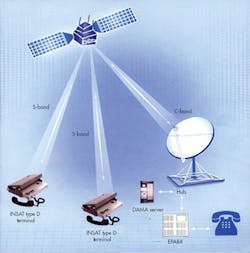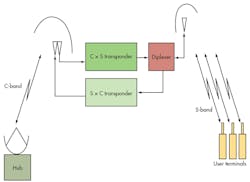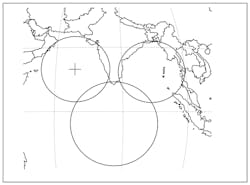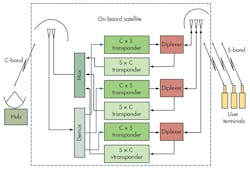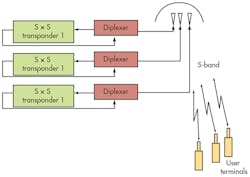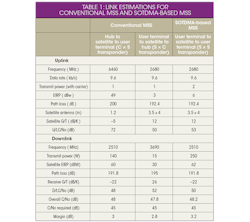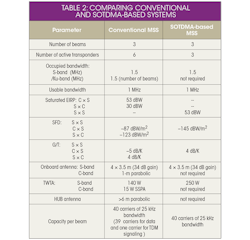This file type includes high resolution graphics and schematics when applicable.
Congestion of multiple signals in different locations around the world calls for intelligent use of available frequencies, and the S-band portion of the spectrum holds great promise for a number of applications. India, for example, enjoys many applications for S-band mobile-satellite-system (MSS) equipment. Demand from private and government sources for more S-band bandwidth on satellites for MSS services increases day by day.
These MSS services are currently provided by means of S × C-band and C × S-band bent-pipe transponders onboard geosynchronous orbit (GEO) satellites. Mobile terminals at S-band frequencies are connected to a hub or control center by satellite transponders using C-band or Ku-band feeder links. Accordingly, any use of S-band frequencies for MSS services requires equal bandwidth at C- or Ku-band frequencies. Optimum utilization of available bandwidth has become a significant challenge in moving these communications systems forward.
Present MSS services adapt access techniques—such as time-division-multiple-access (TDMA) and frequency-division-multiple-access (FDMA) methods— to forge the connectivity needed for data, voice, and video transfers. These systems require centralized control centers, often referred to as hubs, to assign frequency and/or time slots to users automatically as needed. However, to achieve more optimum use of the available RF bandwidth without requiring feeder links (so as to avoid the need for additional C- or Ku-band frequencies), a new scheme has been developed which will be referred to as self-organizing time-division-multiple-access (SOTDMA) technology.
Figure 1 shows the concept of a conventional MSS system, for data and voice communications, as it is used with Indian National Satellite System (INSAT) satellites.1Figure 2 provides a configuration onboard GEO satellites for conventional MSS use. Users link to the GEO satellite with S-band frequencies while the feeder link is operating at C-band frequencies.
The satellite is configured with S × C and C × S transponders. An S-band antenna is designed to cover the required area and is fed with an appropriate power level to achieve the required effective isotropic radiated power (EIRP) level to maintain a good satcom link. The C-band link is supported by a relatively large antenna—a paraboloid design with greater than 6-m diameter—with high gain-to-noise-temperature (G/T) performance at the control center (hub). The system requires a large bandwidth equal to the sum of the users’ uplink S-band carriers’ bandwidth for the C-band feeder/hub link.
An alternative to the current MSS scheme is based on the use of the SOTDMA concept2-4 and does not require a feeder link. The SOTDMA approach allows large number of users to share a single narrowband radio channel by synchronizing their data transmission to an exact timing standard. SOTDMA is based on allowing a user terminal to create a local replica of a current TDMA frame and find a time slot randomly from available vacant slots when the data can be transmitted. GPS timing signals are used to synchronize the time slots at the user terminals, and all user terminals in the visible region will receive the transmitted packets in this scheme.
This SOTDMA concept is a possible option for conserving RF spectrum while also serving a large number of MSS users. An Automatic Identification System (AIS) data/frame structure is assumed for an MSS application.5,6 In practice, any other format can be adopted suitably.
The proposed SOTDMA-based MSS approach offers solid performance within a 25-kHz bandwidth, including a data rate of 9.6 kb/s and 256-b message length using Gaussian minimum-shift-keying (GMSK) modulation and MF-TDMA access. It uses 2250 slots/min in a carrier and CSTDMA/SOTDMA slot allocation with GPS time synchronization. Assuming a detection probability of 90%, the number of users per carrier is estimated at approximately 2000 (2250 × 0.9) with 1-min reporting. In effect, 1000 simultaneous calls can be made per carrier in a 25-kHz bandwidth.
Normally, each user transmits in one slot. A user can reserve more slots to transmit more data if required. Of course, this will affect the number of users possible. Polling can also be incorporated as an added service. With the implementation of the FDMA concept along with SOTDMA, a 1-MHz bandwidth suffices for 40 simultaneous carriers, thereby supporting around 40,000 simultaneous calls. To support 40 simultaneous carriers, a satellite transponder must be designed with sufficient EIRP and G/T, even if greater bandwidth is considered. The proper antenna onboard the satellite can provide the required coverage and can serve all users if it delivers adequate EIRP and G/T performance.
This file type includes high resolution graphics and schematics when applicable.
Delay Considerations
This file type includes high resolution graphics and schematics when applicable.
The satellite range is about 41,000 km (the maximum range if the user terminal “sees” the satellite at a 10-deg. elevation). The total propagation delay of the signal to travel back and forth, or 2 × 41,000 km, will be about 275 ms—or to be conservative, 500 ms including other possible delays, which translates to about 19 slots of the TDMA frame. This may cause collision/overlapping of some time slots if they are synchronized to 60-s periods.
This can be corrected by allowing a 500-ms guard band between frames. Each receiver would synchronize with a GPS reference every 60.5 s and transmit in one of the 2250 slots selected randomly. This built-in discipline among users will avoid overlapping of slots. Proper random sequencing can minimize the chance of two users selecting the same slot for transmission simultaneously. Greater than 90% probability is normally achievable with proper random sequencing for slot selection.
With the assumption of 90% detection probability, 2000 users can transmit or 1000 simultaneous calls per carrier of 25-kHz bandwidth can occur in a 60.5-s time period instead of a 60-s time period using the standard AIS format. A 500-ms time gap in data reception does not pose a problem with current digital communications techniques. But since all users receive the data, appropriate encryption/coding must be implemented to maintain confidentiality. This scheme has some clear advantages: Feeder link carriers are not required and slot allocation is not by hub, so two-way communications for slot synchronization is unnecessary.
In a conventional MSS setup, a high-gain ground antenna for feeder links helps to maintain overall C/N with relatively less satellite EIRP and lower G/T at S-band. In contrast, sufficiently high EIRP must be provided onboard the satellite for an SOTDMA-based MSS setup, as will be shown by an example. The main drawback of requiring more EIRP onboard the satellite compared to a conventional MSS is offset by saving feeder link bandwidth.
Various techniques are being implemented for ship-to-ship and ship-to-shore communications for civilian and naval ships. As an example, consider a typical satellite providing MSS services over the area of sea surrounding the Indian land mass. A single S-band antenna can be designed for the GEO satellite to cover the total Indian land mass and surrounding sea area. For such wide area coverage, the antenna gain will be less and high power will be required onboard the satellite for good G/T and EIRP required for a sustainable satcom link.
To overcome this problem, a three-beam configuration to cover total sea area around the Indian coast land is considered. A typical 3.5 × 4-m antenna with proper feed system onboard a satellite can provide three beams covering the complete coast line and ocean around India (Fig. 3).
Figure 4 shows a typical configuration of a conventional MSS for this example. Each beam is linked to a common hub/control center in the conventional MSS system. Each beam requires independent C × S-band and S × C-band transponders, complicating the onboard hardware. The bandwidth required in the feeder link will equal the sum of the bandwidths of all S-band uplink carriers. A satellite configured with S × S-band transponders in the MSS frequency band with adequate EIRP can support MSS applications using the SOTDMA concept while avoiding the need for feeder links, eliminating the need for RF spectrum at C- or Ku-band frequencies. Figure 5 shows the configuration of a SOTDMA-based MSS.
With the SOTDMA concept, the satellite would have three S × S-band bent-pipe transponders to cater to the three beams. All users would synchronize transmissions to a GPS time standard. User terminals would receive the transmitted signals from satellite, map the received signal frame, and transmit the data in a randomly selected vacant slot. For the example chosen, all users transmit every 60.5 s at an uplink frequency.
The sizing of the power amplifiers for these satcom systems depends upon the bandwidth, the amount of data, and the number of users. Table 1 offers typical link estimations for conventional and SOTDMA-based MSS systems. For a similar margin of around 3 dB, a conventional MSS system requires 140 W transmit power for an S-band downlink. An SOTDMA-based MSS system requires 250 W transmit power for the S-band downlink. Table 2 provides a comparison of the performance levels of a typical bandwidth-equivalent conventional MSS system and an SOTDMA-based MSS system.
A number of observations can be made when comparing a conventional MSS setup with the novel SOTDMA configuration. For one thing, the SOTDMA configuration totally saves the feeder link bandwidth, which is considerable. This is a major consideration for invaluable bandwidth at C- or Ku-band frequencies.
In a conventional MSS configuration, the EIRP requirement for S-band downlink carriers is moderate, as can be seen from the link estimation in Table 1. The hub station antenna, with its high G/T and EIRP, improves the overall link performance. In an S × S-band transponder configuration, only the onboard EIRP determines the link performance. As a tradeoff, the transmit power for an SOTDMA configuration must be higher (250 W versus 140 W) compared to a system with conventional MSS transponders.
In the SOTDMA configuration, since switching and control is carried out by the hub, users can contact other users in any beam. Due to the SOTDMA concept, users covered by a beam can communicate within that beam only. Each beam is configured to cover a particular area. Monitoring/control centers in the coverage area can facilitate interbeam communications through appropriate terrestrial networks and protocols, and a beam shaped to meet the required coverage area can overcome this limitation with suitable high-power amplification. Equipped with the proper protocol, a terminal in an overlapping zone can act as a repeater if required.
Compared to a conventional MSS, the onboard configuration of an SOTDMA-based MSS setup is much simpler. A conventional MSS configuration requires twice the number of transponders and additional multiplexers and demultiplexers compared to the SOTDMA-based MSS setup.
This example involving India has shown the potential effectiveness of a SOTDMA-based MSS configuration, although the approach can be extended to almost any area with the proper transmit EIRP, time-division format, and protocols in place. The approach can save spectrum and reduce satcom system complexity. Adopting the SOTDMA approach involves some reconfiguration of a satcom system configuration in terms of the number of transponders, the power amplifier performance, and the antenna size, but it can provide numerous benefits.
Acknowledgments
The author wishes to thank Dr. K.N.B. Murthy, Vice Chancellor of PES University, Dr. V.K. Agrawal, Director, CORI, and Dr. T.S. Chandar, HOD, E&CE Department, for their encouragement. Thanks are also due to Dr. P.K. Jain, deputy director, SCNP, ISRO HQ for timely help and useful discussions.
V. Sambasiva Rao, Professor
Department of Electronics and Communication Engineering, People’s Education Society (PES) University, Bangalore, India
This file type includes high resolution graphics and schematics when applicable.
References
This file type includes high resolution graphics and schematics when applicable.
1. Satcom & IT Applications Area, Space Applications Center, Ambawadi Vistar P.O. Ahmedabad 380015, India, “INSAT MSS type D System” brochure.
2. Torkild Eriksen, Gudrun HZye, BjZrn Narheim, Bente Jensl, and Zkken Meland, “Maritime trafï¬c monitoring using a space-based AIS receiver,” Acta Astronautica, Vol. 58, 2006, pp. 537-549.
3. Lin Changchuan, Dong Fang Le, and Jie Wang Gaoyao, “AIS system and the applications at the Harbor Traffic Management Wireless Communications,” 4th International IEEE Conference on Networking and Mobile Computing (WiCOM 08), 2008.
4. Ian D’Souza and David Martin, “Nano-sattelite demonstration mission: the detection of maritime AIS signals from low earth orbit,” Small Satellite Systems and Services Symposium, Pestana Conference Centre, Funchal, Madeira, Portugal, May 31, 2010 to June 4 2010.
5. H.S. Lee, S.M. Lee, and H.H. Lee: “The Realization of the Performance Estimation System on AIS SOTDMA Algorithm,” 5th IEEE International Conference on Industrial Informatics, 2007.
6. The International Telecommunications Union (ITU), “Technical Characteristics for a Universal Shipborne Automatic Identification System Using Time Division Multiple Access in the Maritime Mobile Band,” ITU-R Recommendation M.1371-3.
This file type includes high resolution graphics and schematics when applicable.


